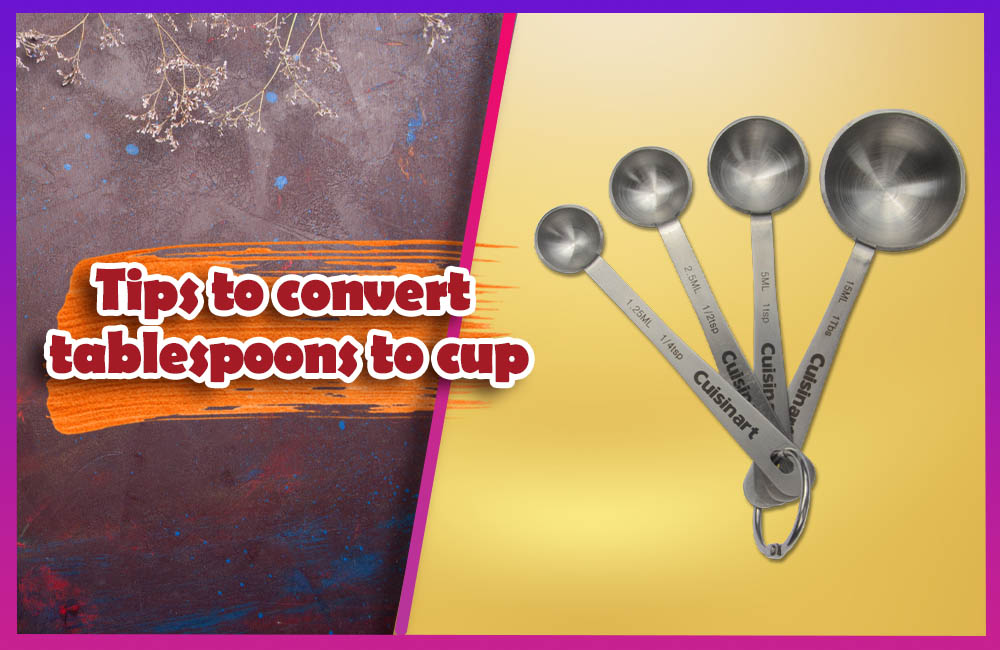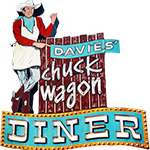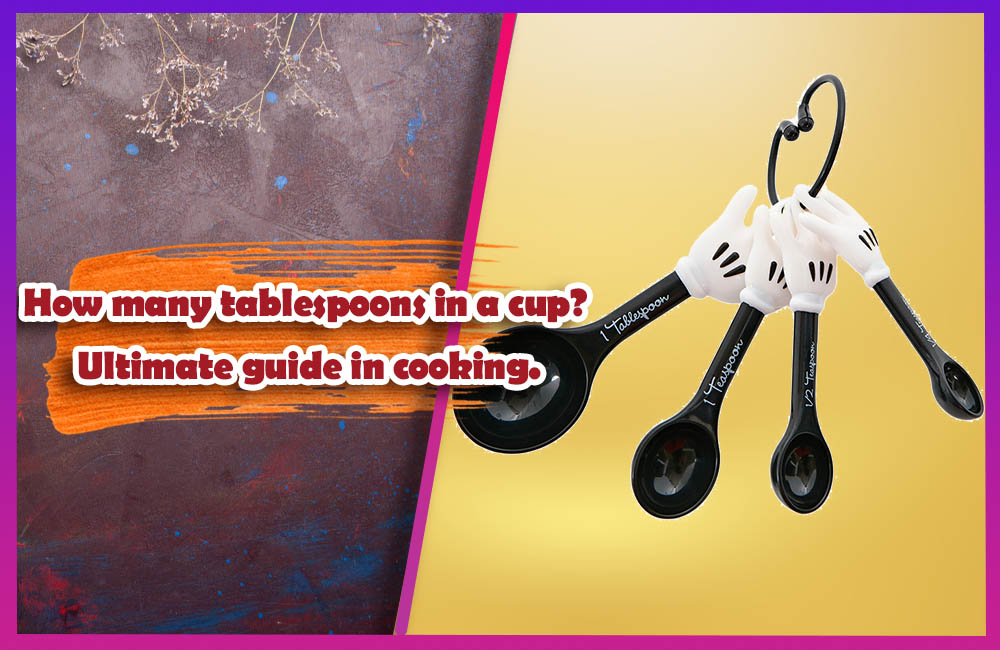How many tablespoons in a cup? Are you an amateur chef and confused about the measurement of tablespoons in a cup?
Then look no further! In this blog post, we are going to take you through a comprehensive guide on all things cooking-related.
Everything from understanding how many tablespoons make up a cup, reading and measuring food labels correctly, and the best way to measure ingredients when dealing with recipes that use both metric and imperial measurements.
Prepare your kitchen tools because it’s time to get cooking!
How many tablespoons in a cup
Table of Contents
In the kitchen, one cup is equal to 16 tablespoons in terms of volume. This is a popular and practical measurement for people to use when baking or cooking.
To calculate this more precisely, you can use the following formula: 1 cup = 16 tablespoons = 8 fluid ounces = 236.5882365 milliliters.
This makes it easy to convert between different types of measurements when necessary. For example, if you need 2 cups and don’t have a measuring cup, you can simply use 32 tablespoons instead.
Additionally, many recipes call for specific amounts of ingredients that are measured in cups and tablespoons, so having this information on hand can be helpful.
When measuring dry ingredients like sugar or flour, it’s important to remember that 1 cup does not always equal 16 tablespoons – it can vary depending on the ingredient.
For example, a cup of sugar is generally considered to be around 12 tablespoons, while a cup of flour is closer to 15 tablespoons. Therefore, it’s important to always check the recipe for exact measurements when using dry ingredients.
With liquid measurements, such as milk or water, the formula of 1 cup = 16 tablespoons is generally accepted.
However, some recipes may call for slightly different amounts depending on their needs. Therefore, it’s best to refer to the recipe when measuring liquids as well.
No matter what type of ingredient you’re measuring out, though, it’s important to use accurate measurements in order to ensure that your recipes turn out as expected.
With this information about how many tablespoons are in a cup handy, you’ll never need to guess again!
What is a tablespoons?
A tablespoon is a unit of measure that is often used in cooking. It is a popular kitchen tool for measuring ingredients such as butter, sugar and flour. A traditional tablespoon measures 1/2 fluid ounce, which is about 15 milliliters.
Though the size can vary slightly depending on the country or region it’s from, most tablespoons are close to this measurement. There are also other types of tablespoons available such as Dry Measurement Tablespoons and Metric Tablespoons.
In addition to being a common kitchen tool, tablespoons are also commonly used in foodservice settings, such as restaurants and cafeterias.
They are useful for accurately measuring out ingredients so recipes can be repeated quickly and easily.
In general, one tablespoon equals three teaspoons; however, there are some exceptions to this rule.
For example, a tablespoon of dry ingredients usually equals four teaspoons. Therefore, it is important to read the measurements carefully whenever using tablespoons in cooking or baking.
It is also important to make sure you use the appropriate type of tablespoon for the task at hand; for instance, a Dry Measurement Tablespoon should not be used when measuring liquid ingredients like oil and water.
In summary, the tablespoon is an essential kitchen tool that is useful for accurately measuring out ingredients so recipes can be repeated quickly and easily. With its versatile uses, it’s no wonder why it’s one of the most popular kitchen tools around!
What is a cup
A cup is a common unit of measurement in the kitchen. It is popular for measuring both dry and liquid ingredients, such as flour, sugar, oil, and water. One cup is equal to 8 fluid ounces or 16 tablespoons.
A standard measuring cup holds 8 fluid ounces or one-half pint. Many recipes use cups as a form of measurement as it allows them to easily scale up or down depending on how many servings they wish to make.
When using cups, it’s important to remember that not all ingredients will fit perfectly into a cup—for instance, some ingredients like grains may need to be leveled off before being added to the measuring cup.
Cups are also used when making coffee and other hot beverages; typically a single cup is equal to 6 ounces of water.
Cups are also a popular choice for serving food and drinks, with most cups holding around 8 ounces of liquid.
Metric cup vs Imperial cup
The two most common types of cups used in cooking are the metric cup and the imperial cup. The metric cup is typically used in countries that use the metric system, while the imperial cup is more commonly used by those who use the imperial measurement system.
Metric Cup: A metric cup holds 250 milliliters (ml) or 8.45 fluid ounces.
It can also be expressed as 0.25 liters (L). This is a standard size for measuring ingredients in recipes from countries such as France, Germany, Spain, Italy and Australia.
Examples:
1 metric cup of flour = 125 grams
1 metric cup of sugar = 200 grams
1 metric cup of oats = 80 grams
1 metric cup of butter = 230 grams
Imperial Cup: An imperial cup holds 284 milliliters (ml) or 9.61 fluid ounces.
It can also be expressed as 0.284 liters (L). This is the standard size used in recipes from countries such as the United Kingdom, Canada and the United States.
Examples:
1 imperial cup of flour = 140
1 imperial cup of sugar = 225 grams
1 imperial cup of oats = 90 grams
1 imperial cup of butter = 250 grams.
Read more:
How many tablespoons in an ounce? Get great tips in measuring.
How many ml in a shot? Useful tips 2023.
How many ml in a gallon: Great notes to remember.
How Many Water Bottles Should I Drink a Day?
Tips to convert tablespoons to cup

1. Convert tablespoons (Tbsp) to teaspoons (tsp).
There are 3 teaspoons in 1 tablespoon, so if you have a recipe that calls for 4 tablespoons of butter, simply multiply it by 3 to get 12 teaspoons.
2. Measure the right amount of ingredient.
Once you’ve determined how many teaspoons of an ingredient you need, measure out that exact amount using measuring spoons.
3. Divide the teaspoon measurements into cups.
One cup equals 16 tablespoons or 48 teaspoons, so divide your total number of teaspoon measurements by 48 to calculate how many cups you need.
For example, if your recipe requires 12 teaspoons of butter, divide 12 by 48 to get 0.25 cups of butter.
4. Round up or down to the nearest cup measurement.
When converting tablespoons to cups, you may find that you have a fraction of a cup left over after dividing the teaspoon measurements by 48.
To account for this, round your total number of cups either up or down to get an even measurement in cups.
5. Use a tablespoon and teaspoon conversion chart when necessary.
If you’re ever unsure of how many teaspoons are in a tablespoon or how many tablespoons are in a cup, refer to a tablespoon and teaspoon conversion chart for help with conversions!
Table chart cup to tablespoon
| Cups | Tablespoons |
|---|---|
| 1/8 cup | 2 tablespoons |
| 1/4 cup | 4 tablespoons |
| 1/3 cup | 5 1/3 tablespoons |
| 3/8 cup | 6 tablespoons |
| 1/2 cup | 8 tablespoons |
| 5/8 cup | 10 tablespoons + 2 teaspoons |
| 2/3 cup | 10 2/3 tablespoons |
| 3/4 cup | 12 tablespoons |
| 7/8 cup | 13 tablespoons + 1 teaspoon |
| 1 cup | 16 tablespoons |
| 2 cups | 32 tablespoons |
| 3 cups | 48 tablespoons |
| 4 cups | 64 tablespoons |
| 5 cups | 80 tablespoons |
Table chart Compare dry and liquid ingredient cup to tablespoon
| Ingredient | 1 cup | 1/2 cup | 1/3 cup | 1/4 cup | 1/8 cup |
|---|---|---|---|---|---|
| All-purpose flour (dry) | 16 tbsp | 8 tbsp | 5 1/3 tbsp | 4 tbsp | 2 tbsp |
| Granulated sugar (dry) | 16 tbsp | 8 tbsp | 5 1/3 tbsp | 4 tbsp | 2 tbsp |
| Brown sugar (dry) | 16 tbsp | 8 tbsp | 5 1/3 tbsp | 4 tbsp | 2 tbsp |
| Powdered sugar (dry) | 16 tbsp | 8 tbsp | 5 1/3 tbsp | 4 tbsp | 2 tbsp |
| Cocoa powder (dry) | 16 tbsp | 8 tbsp | 5 1/3 tbsp | 4 tbsp | 2 tbsp |
| Baking powder (dry) | 48 tsp | 24 tsp | 16 tsp | 12 tsp | 6 tsp |
| Baking soda (dry) | 48 tsp | 24 tsp | 16 tsp | 12 tsp | 6 tsp |
| Salt (dry) | 48 tsp | 24 tsp | 16 tsp | 12 tsp | 6 tsp |
| Vanilla extract (liquid) | 16 tbsp | 8 tbsp | 5 1/3 tbsp | 4 tbsp | 2 tbsp |
| Milk (liquid) | 16 tbsp | 8 tbsp | 5 1/3 tbsp | 4 tbsp | 2 tbsp |
| Water (liquid) | 16 tbsp | 8 tbsp | 5 1/3 tbsp | 4 tbsp | 2 tbsp |
| Oil (liquid) | 16 tbsp | 8 tbsp | 5 1/3 tbsp | 4 tbsp | 2 tbsp |
Measurement dry and liquid ingredient cup to tablespoon
| Cup Measurement | Tablespoon Measurement (Dry Ingredients) | Tablespoon Measurement (Liquid Ingredients) |
|---|---|---|
| 1/8 cup | 2 tbsp | 2 tbsp |
| 1/4 cup | 4 tbsp | 2 tbsp |
| 1/3 cup | 5 1/3 tbsp | 2 tbsp + 2 tsp |
| 3/8 cup | 6 tbsp | 2 tbsp + 2 tsp |
| 1/2 cup | 8 tbsp | 4 tbsp |
| 5/8 cup | 10 tbsp | 1/2 cup |
| 2/3 cup | 10 2/3 tbsp | 1/2 cup + 1 tbsp |
| 3/4 cup | 12 tbsp | 1/2 cup + 2 tbsp |
| 7/8 cup | 14 tbsp | 3/4 cup |
| 1 cup | 16 tbsp | 1 cup |
Table chart convert cup to tablespoons , ml, l, gallon, pint, quart
| Cups | Tablespoons | Milliliters (ml) | Liters (l) | Gallons | Pints | Quarts |
|---|---|---|---|---|---|---|
| 1 | 16 | 236.6 | 0.2366 | 0.0625 | 0.5 | 0.25 |
| 2 | 32 | 473.2 | 0.4732 | 0.125 | 1 | 0.5 |
| 3 | 48 | 709.8 | 0.7098 | 0.1875 | 1.5 | 0.75 |
| 4 | 64 | 946.4 | 0.9464 | 0.25 | 2 | 1 |
| 5 | 80 | 1183 | 1.183 | 0.3125 | 2.5 | 1.25 |
| 6 | 96 | 1419.6 | 1.4196 | 0.375 | 3 | 1.5 |
| 7 | 112 | 1656.2 | 1.6562 | 0.4375 | 3.5 | 1.75 |
| 8 | 128 | 1892.8 | 1.8928 | 0.5 | 4 | 2 |
| 9 | 144 | 2129.4 | 2.1294 | 0.5625 | 4.5 | 2.25 |
| 10 | 160 | 2366 | 2.366 | 0.625 | 5 | 2.5 |
Some recipes use convert tablespoons in cup
1. Chocolate Chip Cookies
– In a medium-sized bowl, mix together 1 cup (16 tablespoons) of butter, 3/4 cup (12 tablespoons) of white sugar and 3/4 cup (12 tablespoons) of brown sugar until light and fluffy.
2. Pancakes
– In a large bowl, whisk together 1 cup (16 tablespoons) of all-purpose flour, 2 teaspoons of baking powder, 1 teaspoon of salt and 2 tablespoons of sugar.
3. Banana Bread
– In a medium-sized bowl, cream together 1/2 cup (8 tablespoons) butter and 1 cup (16 tablespoonsof sugar until light and fluffy.
Add in two eggs and beat well before adding in 2 mashed bananas and stirring until everything is combined.
4. Macaroni and Cheese
– In a medium-sized bowl, mix together 1/2 cup (8 tablespoons) of butter, 1/3 cup (5 tablespoons + 1 teaspoon) of all-purpose flour and 2 cups (32 tablespoons) of milk until smooth.
Add in 8 ounces of cheese and 3 cups (48 tablespoons) of cooked macaroni and stir well before baking in the oven at 350°F for 25 minutes or until golden brown.
FAQs about how many tablespoons in a cup
1. How many tablespoons are in a cup?
– There are 16 tablespoons in 1 cup.
2. What is the most common mistake when measuring ingredients?
– The most common mistake when measuring ingredients is not using the correct measurement conversions. To ensure accurate measurements, always use the same units of measure (cups, teaspoons, tablespoons) throughout a recipe.
3. How can I remember the conversion from tablespoons to cups?
– A helpful trick to remember is that there are 16 tablespoons in 1 cup, and 3 teaspoons in 1 tablespoon.
4. What other units of measure can be used to convert amounts?
– Other units of measure that can be used for conversions include milliliters (ml) and liters (L).
5. When measuring out other ingredients, how do I know how many tablespoons are in each cup?
– Different ingredients may require different measurements of tablespoons per cup. To check the exact measurement, look up the ingredient online or use a conversion chart.
6. What is the most important thing to remember when converting between teaspoons and tablespoons?
– The most important thing to remember is that there are 3 teaspoons in 1 tablespoon.
7. What other amounts can I convert using tablespoons and cups?
– You can also use tablespoons and cups to convert between ounces, grams, and milliliters.
8. Is there a tool or chart I can use when converting between different units of measure?
– Yes! There are many online tools and charts available for converting between different units of measure, such as tablespoons and cups.
9. What if I need to convert from cups to teaspoons?
– To convert from cups to teaspoons, you will need to divide the number of cups by 16 (since there are 16 tablespoons in 1 cup) then multiply the result by 3 (since there are 3 teaspoons in 1 tablespoon).
10. Is there a shortcut for quickly converting between tablespoons and cups?
– Yes! To quickly convert between tablespoons and cups, you can use the following equation: 1 cup = 16 tablespoons.
11. How do I know what measurement to use when cooking or baking?
– When cooking or baking, it is always best to follow the measurements listed in the recipe.
If a recipe calls for teaspoons, then that is the measurement you should use; if it calls for tablespoons, then that is what you should measure out as well.
12. Are there any other tips or tricks I should remember when measuring ingredients?
– Make sure to properly level off your spoon or cup so that you get an accurate measurement each time. Additionally, always refer to a tablespoon as a tablespoon and not a “tbs” or “T.”
13. What should I do if I accidently use the wrong measurements?
– If you have accidently used the wrong measurements, it is best to try and make adjustments to your recipe accordingly.
This may require adding more or less of certain ingredients in order to get the desired outcome.
14. Are there any other units of measure that can be converted using tablespoons and cups?
– Yes! You can also convert between milliliters (ml) and liters (L).
15. Is there an easier way to measure out ingredients instead of using tablespoons and cups?
– Many kitchen gadgets exist that make measuring ingredients easier, such as measuring spoons with markings for different measurements.
Additionally, many measuring cups have lines and markings that indicate how much of an ingredient to use.
Conclusion about how many tablespoons in a cup
To conclude, one cup is equal to 16 tablespoons. This simple conversion can be used when measurements are given in either cups or tablespoons and can be easily remembered by the helpful trick that there are 3 teaspoons in 1 tablespoon.
Additionally, other units of measure such as milliliters (ml) and liters (L) can also be converted using this same ratio.
Using proper measurements and conversions is key to ensuring accurate recipes every time!
When measuring out ingredients, always use the same unit of measurement throughout the recipe and consult a conversion chart or online tool if needed.
Make sure to properly level off your spoon or cup to get an accurate measurement each time, and refer to a tablespoon as a tablespoon instead of abbreviations like “tbs” or “T.”
Finally, if you accidently use the wrong measurement, make sure to adjust your recipe accordingly. With these guidelines in mind, accurate measurements should be easy and stress-free!

I’m Leon Todd and my passion for cooking is my life goal. I’m the owner and operator of Davieschuckwagon.com, a website that specializes in providing high-quality cooking information and resources. I love to experiment with new flavors and techniques in the kitchen, and I’m always looking for ways to improve my skills.
I worked my way up through the ranks, taking on more challenging roles in the kitchen. I eventually became a head chef.
Cooking is more than just a job to me – it’s a passion that I want to share with the world.

